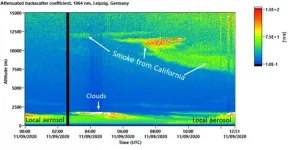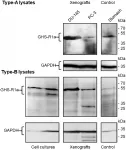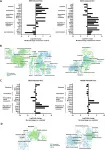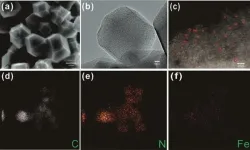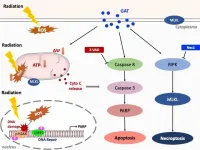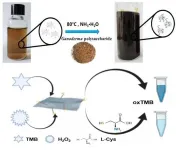Manipulating quinary charge states in solitary defects of 2D intermetallic semiconductor
2021-06-01
(Press-News.org) Single atomic defect is the smallest structural unit of solid material. The construction of devices based on single defect can reach the limit of miniaturization of semiconductor devices. In the past decades, the creation and manipulation of single defects in semiconductors opened a new research field, and could be used to physically realize "qubits" of solid-state quantum computation through spin or electron charge. Most interest have focused on the studies of spin quantum computing. However, the spin manipulation need an optical and magnetic field. On the contrary, multiple charge states can be written and read using only an electric field, which will result in a more compact device size and compatibility with modern electronic technology. A successful charging in single atomic defect needs to overcome Coulomb repulsion energy. The successive multiple charging processes would increase the charging energy quadratically, which easily exceeds the band gap, leading to charging failure. Previous works only observed one or two charging processes.
To manipulate multiple (especially more than two) charge states in solitary defects, a wide band gap with delocalized defect states corresponding to small Coulomb repulsion energy are required. Recently, Jian Gou, Xuguang Wang, Peng Cheng, Kehui Wu from Institute of Physics, Chinese Academy of Sciences, Bingyu Xia, Wenhui Duan, Yong Xu from Tsinghua University, Andrew Wee from National University of Singapore proposed the use of 2D intermetallic semiconductor with delocalized in-gap defect states is a promising solution for the problem of the tradeoff between the band gap and electron delocalization, and made an exciting progress that realized quinary charge states in a single atomic defect.
From the perspective of materials design, materials in the two-dimensional (2D) limit can have various chemical stoichiometries and atomic arrangements, thus offering numerous opportunities to construct intermetallic semiconductor which contains two elements that have very close electronegativity. An example is the 2D Sn2Bi layer that grows successfully on Si(111) surface by the same group [PRL 121, 126801(2018)]. The Sn and Bi atoms in this 2D material form an alternating honeycomb structure, in which the valence electrons in both elements are saturated. Consequently, 2D Sn2Bi has a band gap of ~0.8 eV. Meanwhile, due to the very close electronegativity between Sn and Bi, the intrinsic Bi vacancy can possess the strongly delocalized in-gap defect states. Such delocalization can lower the Coulomb energy significantly, when multiple electrons are charging into the single Bi vacancy simultaneously.
Experimentally, the metallic tip in scanning tunneling microscopy (STM) was used to detect the in-gap defect states and inject electrons to defect states. The electric field applied by the STM tip can act as top gate to induce surface band bending, leading to a shift of the in-gap defect states with respect to the Fermi level. The defect states, once aligned with the Fermi level, will be charged. The relative distance variation between the tip and the defect can regulate the Fermi level of Sn2Bi at the defect position. Thus, as shown in the image, when tip is moved across the Bi vacancy, the four charging peaks can be observed and shift to a higher energy with the tip moving always from the defect, representing five charge states transition from zero to four. By fitting the contours, the four charging energies were obtained to be about 100 meV, which is much smaller than the band gap. The growth of charging energy with increasing charge number is not quadratic but sublinear. The ultralow defect charging energy and the sublinear dependence behavior are distinct from typical quadratic charging behaviors of defects.
In theoretical calculations, the Bi vacancy has four in-gap defect states with delocalized distribution, which can result in low defect charge concentration and weak Coulomb repulsion. The simulation of charge energies on the four defect states of Bi vacancy gives the similarly low value and sublinear growth behavior, supporting the discovery and manipulation of quinary charge states in a single atomic defect.
The successful quinary charging in a single atomic defect by the STM tip demonstrates the smallest demo to realize multiple charge states. Single electron can be charged into the Bi vacancy one-by-one controllably and continuously, which presents a more compact unit for the application of solotronics. Meanwhile, the study about the single defect on Sn2Bi shows a paradigm to find other intermetallic semiconductors for more outstanding multiple charge states with low energy in a single atomic defect.
INFORMATION:
See the article:
Jian Gou, Bingyu Xia, Xuguang Wang, Peng Cheng, Andrew Thye Shen Wee,
Wenhui Duan, Yong Xu, Kehui Wu, Lan Chen
National Science Review, nwab070
https://doi.org/10.1093/nsr/nwab070
[Attachments] See images for this press release:

ELSE PRESS RELEASES FROM THIS DATE:
2021-06-01
Leipzig. The smoke from the extreme forest fires on the US West Coast in September 2020 travelled over many thousands of kilometres to Central Europe, where it continued to affect the atmosphere for days afterwards. A comparison of ground and satellite measurements now shows: The forest fire aerosol disturbed the free troposphere over Leipzig in Germany as never before. An evaluation by an international research team led by the Leibniz Institute for Tropospheric Research (TROPOS) revealed an extraordinary optical thickness on 11 September 2020, which attenuated ...
2021-06-01
Oncotarget published "Development of a ghrelin receptor inverse agonist for positron emission tomograph" which reported that imaging of Ghrelin receptors in vivo provides unique potential to gain deeper understanding on Ghrelin and its receptors in health and disease, in particular, in cancer.
Ghrelin, an octanoylated 28-mer peptide hormone, activates the constitutively active growth hormone secretagogue receptor type 1a with nanomolar activity.
The authors developed novel compounds, derived from the potent inverse agonist K- -FwLL-NH2 but structurally varied by lysine conjugation ...
2021-06-01
Oncotarget published "Global DNA hypermethylation pattern and unique gene expression signature in liver cancer from patients with Indigenous American ancestry" which reported that contrasting with this pattern, the age structure of HCC in Andean people displays a bimodal distribution with half of the patients developing HCC in adolescence and early adulthood.
To deepen the understanding of the molecular determinants of the disease in this population, the authors conducted an integrative analysis of gene expression and DNA methylation in HCC developed by 74 Peruvian patients, including 39 adolescents and young adults.
While genome-wide hypomethylation ...
2021-06-01
New research from the Prevention Research Center of the Pacific Institute for Research and Evaluation, The Ohio State University, and San Jose State University finds that during COVID-19 stay-at-home orders, parental stress was higher during the workday compared to after the workday and lower during weekends than during weekdays.
Previous research compares parental stress before and during the pandemic, but none has measured it during stay-at-home orders. In this study, scientists assessed how time-varying and day-varying factors are related to parents' level of stress. In specific, stress was examined 3 times a day for 14 days for survey participants in Ohio from April to May 2020.
Specific findings include:
Parents ...
2021-06-01
University of Queensland scientists working to unlock the mysteries Australia's deadly stonefish have made a discovery which could change how sting victims are treated in the future.
Stonefish are the most venomous fish in world and are found throughout shallow coastal waters of the northern half of Australia.
Study co-author Associate Professor Bryan Fry said previous studies have not been able to uncover all of the mechanisms at play in stonefish venom because of the way the venom was tested.
"There's a couple of reasons previous studies haven't been able to thoroughly decipher the toxicological mysteries of stonefish venom," Dr Fry said.
"But ...
2021-06-01
Oncotarget published "Multi-modal effects of 1B3, a novel synthetic miR-193a-3p mimic, support strong potential for therapeutic intervention in oncology" which reported that the authors comprehensively investigated miRNA-193a-3p's mode of action in a panel of human cancer cell lines, with a variety of genetic backgrounds, using 1B3, a synthetic microRNA mimic.
Interestingly, the exact mechanism through which 1B3 reduced cell proliferation varied between cell lines.
1B3 efficiently reduced target gene expression, leading to reduced cell proliferation/survival, cell cycle arrest, induction of apoptosis, increased cell senescence, DNA damage, and inhibition of migration.
SiRNA ...
2021-06-01
A local research team, comprised of members of the Korea Institute of Machinery and Materials(KIMM) under the Ministry of Science and ICT and UNIST, developed a metamaterial absorber that significantly enhances the detection of harmful substances or biomolecules, and published their results in Small Methods.
The joint research team led by Principal Researcher Dr. Joo-Yun Jung of the Nano-Convergence Mechanical Systems Research Division at KIMM and Professor Jongwon Lee of UNIST developed a metamaterial that enhances infrared absorption spectroscopy through 100-fold amplification of detection signals. The proposed metamaterial is a special functional material with vertical nanogaps of a smaller size than infrared wavelength.
Infrared spectroscopy is a technique that identifies ...
2021-06-01
Recently, the research team led by Prof. KONG Lingtao from Institute of Solid State Physics, Hefei Institutes of Physical Science (HFIPS) prepared a highly active single iron atom catalyst (Fe-ISAs@CN) which can activate H2O2 to generate free radicals, achieving rapid removal of sulfadiazine pollutants in aqueous. The relevant results were published in Journal of Colloid and Interface Science.
Sulfadiazine (SDZ), a kind of synthetic sulfadiazine antibiotic, is widely used in clinical and animal husbandry industries. However, due to its large-scale use and unqualified discharge of wastewater, more and more antibiotic residues ...
2021-06-01
Recently, the research team led by Prof. KONG Lingtao from Institute of Solid State Physics, Hefei Institutes of Physical Science (HFIPS) prepared a highly active single iron atom catalyst (Fe-ISAs@CN) which can activate H2O2 to generate free radicals, achieving rapid removal of sulfadiazine pollutants in aqueous. The relevant results were published in Journal of Colloid and Interface Science.
Sulfadiazine (SDZ), a kind of synthetic sulfadiazine antibiotic, is widely used in clinical and animal husbandry industries. However, due to its large-scale use and unqualified discharge of wastewater, more and more antibiotic residues are detected in the ...
2021-06-01
Graphene-based materials can be obtained using various reducing agents, many of which are dangerous and toxic chemicals, and the obtained graphene-based materials are prone to aggregation, limiting their practical applications.
Recently, a research group of Prof. HUANG Qing from the Institute of Intelligent Machines, Hefei Institutes of Physical Science (HFIPS), prepared graphene-based nanozymes through a simple and green preparation method, and verified that it can be used to detect L-cysteine in serum.
The study, published in Analytical and Bioanalytical Chemistry, was supported by the National Natural Science Foundation ...
LAST 30 PRESS RELEASES:
[Press-News.org] Manipulating quinary charge states in solitary defects of 2D intermetallic semiconductor

